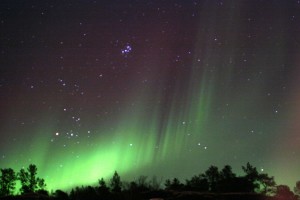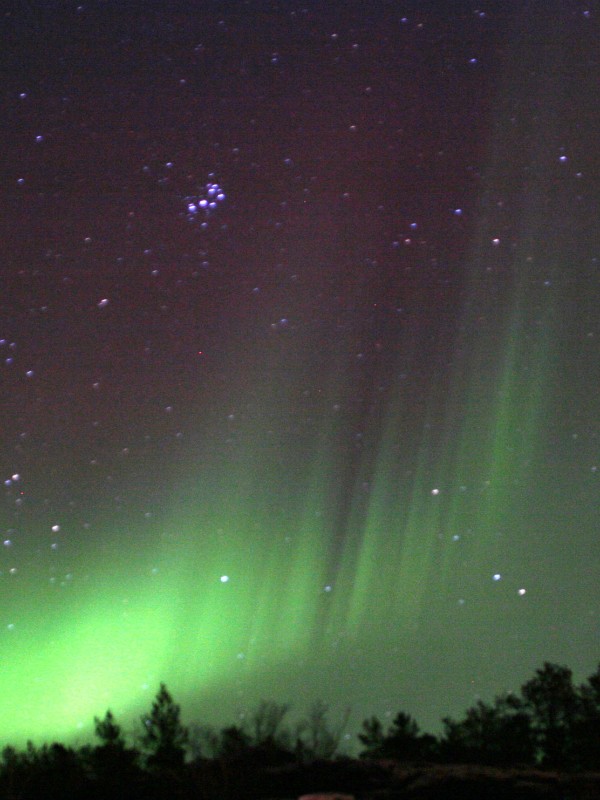Nordlyset/ Aurora polaris
Aurora polaris (polarlys) er et fysisk fenomen som forekommer når solvinden er kraftigere enn normalt, med store elektriske utladninger som slynger elektriske ladete partikler mot Jorden. Partiklene er elektroner og protoner som danner lys når de kolliderer med gassene i jordas atmosfære. Elektronene i gassene gir ut energi i form av elektromagnetisk stråling. Polarlyset befinner seg i en høyde på mellom 90 og over 180 km over bakken. Fenomenet kan observeres på nattehimmelen i et belte rundt de magnetiske polene. Polarlys viser seg som et bølgende lys som varierer både i form, farge og styrke, fra mørkeblå innom grønn og gul, til rød og oransje.
Norge deltar aktivt i internasjonal nordlysforskning, blant annet gjennom Andøya Space Center.
Fenomenet har blitt observert og fotografert fra bakkenivå så langt sør i Norge som i Kristiansand.
Nordlysovalen er det området i atmosfæren der nordlyset forekommer. Det er i dette området de ladde partiklene treffer jordatmosfæren og avgir energi i kollisjon med molekyler og atomer i atmosfæren. Nordlysovalen har forskjellig plassering om natta og om dagen. Om natta er nordlysovalen rett over Nord-Norge.
Kilde: Wikipedia
Slik oppstår nordlyset
Fortellingen om nordlyset begynner på sola, og ender i jordas magnetfelt. Se video og animasjoner om solvindens reise gjennom solsystemet (forskning.no).
Lyset og varmen fra sola holder liv i oss og gjør jorda til en frodig klode.
Når sollyset flommer ned en fin vårdag, kan det være rart å tenke på at sola også lager en annen type lys: nordlyset glir som slør over polarhimmelen i mørke vinternetter.
Men nordlyset ble født i hete. Det var opprinnelig en boble av en milliard tonn glødende gass, slynget ut av kraftige magnetfelt på sola.
Med en fart på åtte millioner kilometer i timen legger bobla ut på den lange reisen mot jorda. Tross den voldsomme farten, bruker den likevel 18 timer på å tilbakelegge de 150 millioner kilometrene, forbi planetene Merkur og Venus.
Alt dette kan du se i denne videoen, som er produsert av forskning.no i samarbeid med Fysisk institutt ved Universitetet i Oslo.
Du kan også se hva som skjer når bobla av glødende gass treffer magnetfeltet rundt jorda, og blir til nordlys.
Kilde: Per Byhring, forskning.no
Northern Lights/ Aurora polaris
Aurora polaris is a physical phenomenon that occurs when the solar winds are stronger than normal, with large electrical discharges that fling electrically charged particles toward Earth. The particles are electrons and protons that create light when they collide with gases in Earth’s atmosphere. The electrons in the gases gives out energy in the form of electromagnetic radiation. Polar lights are located at an altitude of between 56 and over 112 mi above the earth. The phenomenon can be observed in the night sky in a belt around the magnetic poles. The aurora emerges as an undulating light that varies in form, color and strength, from dark blue, green and yellow, to red and orange.
Norway participates actively in international aurora research, through Andøya Space Center among other places.
The phenomenon has been observed and photographed from ground level as far south in Norway as Kristiansand.
The auroral ovla is the area in the atmosphere where the northern lights occur. It is in this area the charged particles hit Earth’s atmosphere and emit energy in collisions with molecules and atoms in the atmosphere. The auroral oval has a different location during the night and day. At night the auroral oval is just above northern Norway.
Source: Wikipedia
How the northern lights occur
The northern lights start with the sun, and ends in the Earth’s magnetic field. See video and animations about the solar wind travel through the solar system (forskning.no).
The light and heat from the sun keeps us alive and makes the soil to a lush planet.
When sunlight floods down a nice spring day, it might be strange to think that the sun also creates a different type of light: the northern lights glide like a veil over the polar sky in dark winter nights.
But the northern lights was born in heat. It was originally a bubble of a billion tons of glowing gas ejected by strong magnetic fields on the sun.
With a speed of five million mph the bubble sets out on the long journey towards Earth. Despite the fierce pace, it still uses 18 hours to traverse the 93 million miles, past the planets Mercury and Venus.
All this you can see in this video, which is produced by forskning.no in collaboration with the Department of Physics at the University of Oslo.
You can also see what happens when the bubble of glowing gas hits the magnetic field around the Earth, and becomes northern lights.
Source: Per Byhring, forskning.com
/esh


